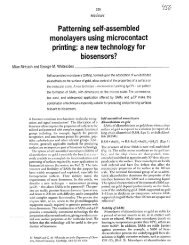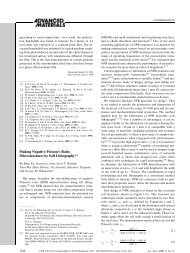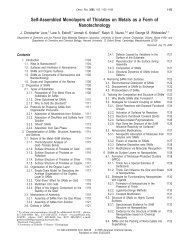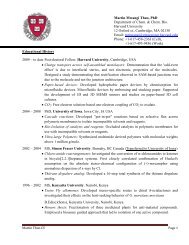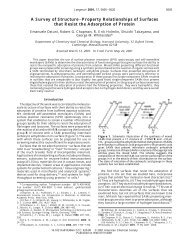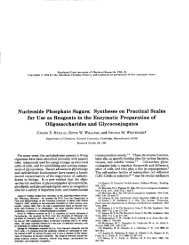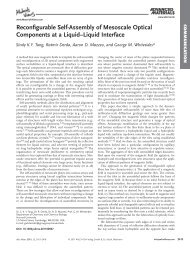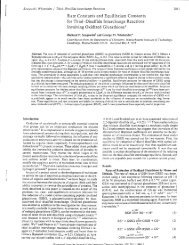Self-Assembly at All Scales - Whitesides Research Group
Self-Assembly at All Scales - Whitesides Research Group
Self-Assembly at All Scales - Whitesides Research Group
Create successful ePaper yourself
Turn your PDF publications into a flip-book with our unique Google optimized e-Paper software.
2418<br />
8. C. Alexander, C. P. Jariwala, C. M. Lee, A. C. Griffin,<br />
Macromol. Symp. 77, 283 (1994).<br />
9. T. K<strong>at</strong>o, H. Kihara, U. Kumar, T. Uryu, J. M. J. Fréchet,<br />
Angew. Chem. Int. Ed. Eng. 33, 1644 (1994).<br />
10. M. Muthukumar, C. K. Ober, E. L. Thomas, Science<br />
277, 1225 (1997).<br />
11. C. Tschierske, J. M<strong>at</strong>er. Chem. 11, 2647 (2001).<br />
12. , J. M<strong>at</strong>er. Chem. 8, 1485 (1998).<br />
13. K. Kanie et al., J. M<strong>at</strong>er. Chem. 11, 2875 (2001).<br />
14. V. Percec, W.-D. Cho, P. E. Mosier, G. Ungar, D. J. P.<br />
Yeardley, J. Am. Chem. Soc. 120, 11061 (1998).<br />
15. N. Zimmerman, J. S. Moore, S. C. Zimmerman, Chem.<br />
Ind. 1998, 604 (1998).<br />
16. L. Brunsveld, B. J. B. Folmer, E. W. Meijer, R. P.<br />
Sijbesma, Chem. Rev. 101, 4071 (2001).<br />
17. L. Zhang, K. Yu, A. Eisenberg, Science 272, 1777 (1996).<br />
18. V. Abetz, in Supramolecular Polymers, A. Ciferri, Ed.<br />
(Dekker, New York, 2000), chap. 6.<br />
19. M. A. Hillmyer et al., Science 271, 976 (1996).<br />
20. R. Elsäer, G. H. Mehl, J. W. Goodby, M. Veith, Angew.<br />
Chem. Int. Ed. Eng. 40, 2688 (2001).<br />
21. B. Dardel, D. Guillon, B. Heinrich, R. Deschenaux, J.<br />
M<strong>at</strong>er. Chem. 11, 2814 (2001).<br />
22. M. Yamada, I. Tsukasa, A. Hirao, S. Nakahama, J.<br />
W<strong>at</strong>anabe, Macromolecules 28, 50 (1995).<br />
23. J. Ruokolainen et al., Science 280, 557 (1998).<br />
24. M. C. Luyten et al., Macromolecules 31, 9160 (1998).<br />
25. R. C. Smith, W. M. Fischer, D. L. Gin, J. Am. Chem. Soc.<br />
119, 4092 (1997).<br />
26. N. Mizoshita et al., Chem. Commun. 2002, 428<br />
(2002).<br />
27. V. Percec, J. A. Heck, D. Tomazos, G. Ungar, J. Chem.<br />
Soc. Perkin Trans. 2 1993, 2381 (1993).<br />
28. Y. Zheng et al., J. M<strong>at</strong>er. Chem. 10, 69 (2000).<br />
29. T. Ohtake et al., Chem. M<strong>at</strong>er. 12, 782 (2000).<br />
30. M. Yoshio et al., Adv. M<strong>at</strong>er. 14, 351 (2002).<br />
31. T. K<strong>at</strong>o, T. Kutsuna, K. Hanabusa, M. Ukon, Adv.<br />
M<strong>at</strong>er. 10, 606 (1998).<br />
32. N. Mizoshita, K. Hanabusa, T. K<strong>at</strong>o, Adv. M<strong>at</strong>er. 11,<br />
392 (1999).<br />
33. N. Mizoshita, Y. Suzuki, K. Kishimoto, K. Hanabusa, T.<br />
K<strong>at</strong>o, unpublished d<strong>at</strong>a.<br />
34. N. Mizoshita, T. Kutsuna, K. Hanabusa, T. K<strong>at</strong>o, Chem.<br />
Commun. 1999, 781 (1999).<br />
35. J. Yamamoto, H. Tanaka, N<strong>at</strong>ure 409, 325 (2001).<br />
36. J. O. Rädler, I. Koltover, T. Salditt, C. R. Safinya,<br />
Science 275, 810 (1997).<br />
37. J. O. Rädler, I. Koltover, A. Jamieson, T. Salditt, C. R.<br />
Safinya, Langmuir 14, 4272 (1998).<br />
38. N. L. Slack et al., Macromolecules 31, 8503 (1998).<br />
39. H. E. Warriner, S. H. J. Idziak, N. L. Slack, P. Davidson,<br />
C. R. Safinya, Science 271, 969 (1996).<br />
40. E. Evans, H. Bowman, A. Leung, D. Needham, D.<br />
Tirrell, Science 273, 933 (1996).<br />
41. D. Adam et al., N<strong>at</strong>ure 371, 141 (1994).<br />
42. N. Boden et al., Phys. Rev. B 52, 13274 (1995).<br />
43. A. Sautter, C. Thalacker, F. Würthner, Angew. Chem.<br />
Int. Ed. Eng. 40, 4425 (2001).<br />
VIEWPOINT<br />
<strong>Self</strong>-<strong>Assembly</strong> <strong>at</strong> <strong>All</strong> <strong>Scales</strong><br />
George M. <strong>Whitesides</strong>* and Bartosz Grzybowski<br />
<strong>Self</strong>-assembly is the autonomous organiz<strong>at</strong>ion of components into p<strong>at</strong>terns<br />
or structures without human intervention. <strong>Self</strong>-assembling processes<br />
are common throughout n<strong>at</strong>ure and technology. They involve components<br />
from the molecular (crystals) to the planetary (we<strong>at</strong>her systems) scale and<br />
many different kinds of interactions. The concept of self-assembly is used<br />
increasingly in many disciplines, with a different flavor and emphasis in<br />
each.<br />
There are several reasons for interest in selfassembly<br />
(1, 2). First, humans are <strong>at</strong>tracted<br />
by the appearance of order from disorder.<br />
Second, living cells self-assemble, and understanding<br />
life will therefore require understanding<br />
self-assembly. The cell also offers<br />
countless examples of functional self-assembly<br />
th<strong>at</strong> stimul<strong>at</strong>e the design of non-living<br />
systems. Third, self-assembly is one of the<br />
few practical str<strong>at</strong>egies for making ensembles<br />
of nanostructures. It will therefore be an essential<br />
part of nanotechnology. Fourth, manufacturing<br />
and robotics will benefit from applic<strong>at</strong>ions<br />
of self-assembly. Fifth, self-assembly<br />
is common to many dynamic, multicomponent<br />
systems, from smart m<strong>at</strong>erials and<br />
self-healing structures to netted sensors and<br />
computer networks. Finally, the focus on<br />
spontaneous development of p<strong>at</strong>terns bridges<br />
the study of distinct components and the<br />
study of systems with many interacting com-<br />
Department of Chemistry and Chemical Biology, Harvard<br />
University, Cambridge, MA 02138, USA.<br />
*To whom correspondence should be addressed. Email:<br />
gwhitesides@gmwgroup.harvard.edu<br />
S UPRAMOLECULAR C HEMISTRY AND S ELF-ASSEMBLY<br />
ponents. It thereby connects reductionism to<br />
complexity and emergence (3).<br />
Is Anything Not <strong>Self</strong>-<strong>Assembly</strong>?<br />
“<strong>Self</strong>-assembly” is not a formalized subject,<br />
and definitions of the term “self-assembly”<br />
seem to be limitlessly elastic. As a result, the<br />
term has been overused to the point of cliché.<br />
Processes ranging from the non-covalent associ<strong>at</strong>ion<br />
of organic molecules in solution to<br />
the growth of semiconductor quantum dots<br />
on solid substr<strong>at</strong>es have been called selfassembly.<br />
Here, we limit the term to processes<br />
th<strong>at</strong> involve pre-existing components (separ<strong>at</strong>e<br />
or distinct parts of a disordered structure),<br />
are reversible, and can be controlled by<br />
proper design of the components. “<strong>Self</strong>-assembly”<br />
is thus not synonymous with<br />
“form<strong>at</strong>ion.”<br />
Types of <strong>Self</strong>-<strong>Assembly</strong><br />
There are two main kinds of self-assembly:<br />
st<strong>at</strong>ic and dynamic. St<strong>at</strong>ic self-assembly (S)<br />
(Table 1; Fig. 1) involves systems th<strong>at</strong> are <strong>at</strong><br />
global or local equilibrium and do not dissi-<br />
29 MARCH 2002 VOL 295 SCIENCE www.sciencemag.org<br />
44. P. Bonhôte, A.-P. Dias, N. Papageorgiou, K. Kalyanasundaram,<br />
M. Grätzel, Inorg. Chem. 35, 1168 (1996).<br />
45. T. Welton, Chem. Rev. 99, 2071 (1999).<br />
46. G. P. Crawford, S. Zumer, Eds., Liquid Crystals in<br />
Complex Geometries (Taylor & Francis, London,<br />
1996).<br />
47. D.-K. Yang, L.-C. Chien, J. W. Doane, Appl. Phys. Lett.<br />
60, 3102 (1992).<br />
48. T. Kajiyama, A. Miyamoto, H. Kikuchi, Y. Morimura,<br />
Chem. Lett. 1989, 813 (1989).<br />
49. R. A. M. Hikmet, Adv. M<strong>at</strong>er. 4, 679 (1992).<br />
50. C. A. Guymon et al., Science 275, 57 (1997).<br />
51. H. Furue, T. Takahashi, S. Kobayashi, Jpn. J. Appl. Phys.<br />
38, 5660 (1999).<br />
52. D. J. Abdallah, R. G. Weiss, Adv. M<strong>at</strong>er. 12, 1237<br />
(2000).<br />
53. M. C. W. van Boxtel, R. H. C. Janssen, D. J. Broer,<br />
H. T. A. Wilderbeek, C. W. M. Bastiaansen, Adv. M<strong>at</strong>er.<br />
12, 753 (2000).<br />
54. S. P. Meeker, W. C. K. Poon, J. Crain, E. M. Terentjev,<br />
Phys. Rev. E 61, R6083 (2000).<br />
55. M. W. P. L. Baars et al., Adv. M<strong>at</strong>er. 12, 715 (2000).<br />
56. S. M. Yu et al., N<strong>at</strong>ure 389, 167 (1997).<br />
57. H.-A. Klok, J. J. Hwang, S. N. Iyer, S. I. Stupp, Macromolecules<br />
35, 746 (2002).<br />
58. We thank many collabor<strong>at</strong>ors for the work presented<br />
here and H. Ohno and K. Hanabusa for discussion and<br />
collabor<strong>at</strong>ion. Supported by the Japanese Ministry of<br />
Educ<strong>at</strong>ion, Culture, Sports, Science, and Technology.<br />
p<strong>at</strong>e energy. For example, molecular crystals<br />
(4, 5) are formed by st<strong>at</strong>ic self-assembly; so<br />
are most folded, globular proteins. In st<strong>at</strong>ic<br />
self-assembly, form<strong>at</strong>ion of the ordered structure<br />
may require energy (for example in the<br />
form of stirring), but once it is formed, it is<br />
stable. Most research in self-assembly has<br />
focused on this st<strong>at</strong>ic type<br />
In dynamic self-assembly (D) (Table 1;<br />
Fig. 2), the interactions responsible for the<br />
form<strong>at</strong>ion of structures or p<strong>at</strong>terns between<br />
components only occur if the system is<br />
dissip<strong>at</strong>ing energy. The p<strong>at</strong>terns formed by<br />
competition between reaction and diffusion<br />
in oscill<strong>at</strong>ing chemical reactions (6, 7) are<br />
simple examples; biological cells are much<br />
more complex ones. The study of dynamic<br />
self-assembly is in its infancy.<br />
We define two further variants of selfassembly.<br />
In templ<strong>at</strong>ed self-assembly (T), interactions<br />
between the components and regular<br />
fe<strong>at</strong>ures in their environment determine<br />
the structures th<strong>at</strong> form. Crystalliz<strong>at</strong>ion on<br />
surfaces th<strong>at</strong> determine the morphology of<br />
the crystal is one example (8, 9); crystalliz<strong>at</strong>ion<br />
of colloids in three-dimensional optical<br />
fields is another (10). The characteristic of<br />
biological self-assembly (B) is the variety<br />
and complexity of the functions th<strong>at</strong> it<br />
produces.<br />
Common Fe<strong>at</strong>ures of <strong>Self</strong>-<strong>Assembly</strong><br />
<strong>Self</strong>-assembly reflects inform<strong>at</strong>ion coded (as<br />
shape, surface properties, charge, polarizabil-
ity, magnetic dipole, mass, etc.) in individual<br />
components; these characteristics determine<br />
the interactions among them. The design of<br />
components th<strong>at</strong> organize themselves into desired<br />
p<strong>at</strong>terns and functions is the key to<br />
applic<strong>at</strong>ions of self-assembly.<br />
The components must be able to move<br />
with respect to one another. Their steadyst<strong>at</strong>e<br />
positions balance <strong>at</strong>tractions and repulsions.<br />
Molecular self-assembly involves noncovalent<br />
or weak covalent interactions (van<br />
der Waals, electrost<strong>at</strong>ic, and hydrophobic in-<br />
Fig. 1. Examples of st<strong>at</strong>ic<br />
self-assembly. (A) Crystal<br />
structure of a ribosome. (B)<br />
<strong>Self</strong>-assembled peptideamphiphile<br />
nanofibers. (C)<br />
An array of millimetersized<br />
polymeric pl<strong>at</strong>es assembled<br />
<strong>at</strong> a w<strong>at</strong>er/perfluorodecalin<br />
interface by<br />
capillary interactions. (D)<br />
Thin film of a nem<strong>at</strong>ic liquid<br />
crystal on an isotropic<br />
substr<strong>at</strong>e. (E) Micrometersized<br />
metallic polyhedra<br />
folded from planar substr<strong>at</strong>es.<br />
(F) A three-dimensional<br />
aggreg<strong>at</strong>e of micrometer<br />
pl<strong>at</strong>es assembled by<br />
capillary forces. [Image<br />
credits: (A) from (24); (B)<br />
from (25); (C) from (26);<br />
(D) from (27); (E) from<br />
(28); (F) from (29)]<br />
S UPRAMOLECULAR C HEMISTRY AND S ELF-ASSEMBLY<br />
teractions, hydrogen and coordin<strong>at</strong>ion<br />
bonds). In the self-assembly of larger components—meso-<br />
or macroscopic objects—interactions<br />
can often be selected and tailored,<br />
and can include interactions such as gravit<strong>at</strong>ional<br />
<strong>at</strong>traction, external electromagnetic<br />
fields, and magnetic, capillary, and entropic<br />
interactions, which are not important in the<br />
case of molecules.<br />
Because self-assembly requires th<strong>at</strong> the<br />
components be mobile, it usually takes place<br />
in fluid phases or on smooth surfaces. The<br />
Table 1. Examples of self-assembly (S, st<strong>at</strong>ic, D, dynamic, T, templ<strong>at</strong>ed, B, biological).<br />
environment can modify the interactions between<br />
the components; the use of boundaries<br />
and other templ<strong>at</strong>es in self-assembly is particularly<br />
important, because templ<strong>at</strong>es can reduce<br />
defects and control structures.<br />
Equilibr<strong>at</strong>ion is usually required to reach<br />
ordered structures. If components stick together<br />
irreversibly when they collide, they<br />
form a glass r<strong>at</strong>her than a crystal or other<br />
regular structure. <strong>Self</strong>-assembly requires th<strong>at</strong><br />
the components either equilibr<strong>at</strong>e between<br />
aggreg<strong>at</strong>ed and non-aggreg<strong>at</strong>ed st<strong>at</strong>es, or adjust<br />
their positions rel<strong>at</strong>ive to one another<br />
once in an aggreg<strong>at</strong>e.<br />
Dynamic <strong>Self</strong>-<strong>Assembly</strong><br />
Although much of current understanding<br />
of self-assembly comes from the examin<strong>at</strong>ion<br />
of st<strong>at</strong>ic systems, the gre<strong>at</strong>est challenges, and<br />
opportunities, lie in studying dynamic systems.<br />
Perhaps the most important justific<strong>at</strong>ion<br />
for studying self-assembly is its central<br />
role in life. The components of a cell replic<strong>at</strong>e<br />
and assemble into another cell during mitosis;<br />
bacteria swarm (11); fish school (12, 13).<br />
Most efforts in biology have focused on st<strong>at</strong>ic<br />
self-assembly. Life is, however, dynamic:<br />
stop the flux of energy through the cell and it<br />
dies.<br />
We understand th<strong>at</strong> the living cell is a<br />
sack th<strong>at</strong> contains a number of reacting chemicals,<br />
is studded with environmental sensors,<br />
and allows he<strong>at</strong> and certain chemicals to pass<br />
across its walls. We also understand th<strong>at</strong> the<br />
cell is a structure th<strong>at</strong> is enclosed, self-replic<strong>at</strong>ing,<br />
energy dissip<strong>at</strong>ing, and adaptive. Yet<br />
we have little idea how to connect these two<br />
sets of characteristics. How does “life”<br />
emerge from a system of chemical reactions?<br />
<strong>Self</strong>-assembly may be one thread th<strong>at</strong> connects<br />
the rel<strong>at</strong>ive simplicity of chemical reactions<br />
to the complexity of the dividing cell.<br />
At the molecular level, st<strong>at</strong>ic self-assembly<br />
describes form<strong>at</strong>ion of the lipid bilayer, pairing<br />
of bases, and folding of some proteins.<br />
The behavior of critical structures in the<br />
System Type Applic<strong>at</strong>ions/importance References<br />
Atomic, ionic, and molecular crystals S M<strong>at</strong>erials, optoelectronics (1, 4, 5)<br />
Phase-separ<strong>at</strong>ed and ionic layered polymers S (19)<br />
<strong>Self</strong>-assembled monolayers (SAMs) S, T Microfabric<strong>at</strong>ion, sensors, nanoelectronics (8)<br />
Lipid bilayers and black lipid films S Biomembranes, emulsions (20)<br />
Liquid crystals S Displays (21)<br />
Colloidal crystals S Band gap m<strong>at</strong>erials, molecular sieves (9, 18)<br />
Bubble rafts S Models of crack propag<strong>at</strong>ion (22)<br />
Macro- and mesoscopic structures (MESA) S or D, T Electronic circuits (14–16)<br />
Fluidic self-assembly S, T Microfabric<strong>at</strong>ion (23)<br />
“Light m<strong>at</strong>ter” D, T (10)<br />
Oscill<strong>at</strong>ing and reaction-diffusion reactions D Biological oscill<strong>at</strong>ions (6, 7)<br />
Bacterial colonies D, B (11)<br />
Swarms (ants) and schools (fish) D, B New models for comput<strong>at</strong>ion/optimiz<strong>at</strong>ion (12, 13)<br />
We<strong>at</strong>her p<strong>at</strong>terns D (1)<br />
Solar systems D<br />
Galaxies D<br />
www.sciencemag.org SCIENCE VOL 295 29 MARCH 2002 2419
2420<br />
cell—including actin filaments, histones and<br />
chrom<strong>at</strong>in, and protein aggreg<strong>at</strong>es in signaling<br />
p<strong>at</strong>hways—involves dynamic self-assembly.<br />
The complex processes th<strong>at</strong> occur in<br />
Fig. 2. Examples of dynamic<br />
self-assembly. (A) An optical<br />
micrograph of a cell with fluorescently<br />
labeled cytoskeleton<br />
and nucleus; microtubules<br />
(24 nm in diameter) are colored<br />
red. (B) Reaction-diffusion<br />
waves in a Belousov-Zab<strong>at</strong>inski<br />
reaction in a 3.5-inch<br />
Petri dish. (C) A simple aggreg<strong>at</strong>e<br />
of three millimeter-sized,<br />
rot<strong>at</strong>ing, magnetized disks interacting<br />
with one another via<br />
vortex-vortex interactions. (D)<br />
A school of fish. (E) Concentric<br />
rings formed by charged metallic<br />
beads 1 mm in diameter<br />
rolling in circular p<strong>at</strong>hs on a<br />
dielectric support. (F) Convection<br />
cells formed above a microp<strong>at</strong>terned<br />
metallic support.<br />
The distance between the centers<br />
of the cells is 2 mm.<br />
[Image credits: (A) from (30);<br />
(B) from (26); (C) from (31)]<br />
S UPRAMOLECULAR C HEMISTRY AND S ELF-ASSEMBLY<br />
Fig. 3. Applic<strong>at</strong>ions of selfassembly.<br />
(A)A2by2cross<br />
array made by sequential<br />
assembly of n-type InP<br />
nanowires with orthogonal<br />
flows. (B) Diffraction gr<strong>at</strong>ing<br />
formed on the surface<br />
of a poly(dimethylsiloxane)<br />
sphere 1 mm in diameter.<br />
The sphere was compressed<br />
between two glass slides,<br />
and its free surface was exposed<br />
to oxygen plasma.<br />
Upon release of compression,<br />
the oxidized surface of<br />
the polymer buckled with a<br />
uniform wavelength of 20<br />
m. (C) Three-dimensional<br />
electronic circuits self-assembled<br />
from millimetersized<br />
polyhedra with electronic<br />
components (LEDs)<br />
embossed on their faces. (D)<br />
An artificial, ferromagnetic<br />
opal prepared by templ<strong>at</strong>ed<br />
self-assembly of polymeric<br />
microbeads. The optical<br />
properties of the aggreg<strong>at</strong>e<br />
can be adjusted by modifying<br />
external magnetic field.<br />
[Image credits: (A) from (32); (B) from (16); (C) from (26); (D) from (33)]<br />
mitosis involve every type of self-assembly.<br />
A hierarchy of self-assembling processes is<br />
thus fundamental to the oper<strong>at</strong>ion of cell.<br />
Dynamic self-assembly is also common in<br />
29 MARCH 2002 VOL 295 SCIENCE www.sciencemag.org<br />
nonliving systems, although these processes<br />
are less studied, and less understood, than<br />
those in living systems. Oscill<strong>at</strong>ing reactions<br />
in solution and on the surface of c<strong>at</strong>alysts,<br />
Rayleigh-Bernard convection cells, p<strong>at</strong>terns<br />
th<strong>at</strong> form in fluidized beds of particles, and<br />
storm cells in the <strong>at</strong>mosphere are all examples;<br />
Table 1 lists others.<br />
<strong>Self</strong>-<strong>Assembly</strong> in Designed Systems<br />
A difficulty in studying self-assembly in living<br />
cells (and in many nonliving systems) is<br />
th<strong>at</strong> it is impractical to change many of the<br />
parameters th<strong>at</strong> determine the behavior of the<br />
systemthe components and the interactions<br />
among them—and thus difficult to test hypotheses<br />
rel<strong>at</strong>ing structures and properties of<br />
these components and the aggreg<strong>at</strong>es th<strong>at</strong><br />
they form. We wished to have available a set<br />
of self-assembling components in which<br />
these parameters could be changed easily, in<br />
order to understand (and to be able to manipul<strong>at</strong>e)<br />
the processes by which components<br />
self-assembled into aggreg<strong>at</strong>es. With this objective,<br />
we have studied the self-assembly of<br />
polyhedral pl<strong>at</strong>es or disks—a few millimeters<br />
wide and a millimeter high—flo<strong>at</strong>ing <strong>at</strong> the<br />
interface between w<strong>at</strong>er and perfluorodecalin<br />
(14). These sizes are <strong>at</strong>tractive because the<br />
components can be fabric<strong>at</strong>ed and observed<br />
easily, and because the interactions between<br />
these components are under precise experimental<br />
control. St<strong>at</strong>ic versions of this system<br />
depend on capillary interactions (15) between<br />
menisci <strong>at</strong> the edges of the pl<strong>at</strong>es, and<br />
typically produce ordered aggreg<strong>at</strong>es with<br />
irregular edges. The processes observed <strong>at</strong><br />
millimeter dimensions scale (with some modific<strong>at</strong>ion)<br />
to submicron dimensions. Templ<strong>at</strong>ing<br />
produces aggreg<strong>at</strong>es with defined shape.<br />
When drops of liquid are p<strong>at</strong>terned on the<br />
faces of components suspended in an immiscible,<br />
isodense fluid, three-dimensional structures<br />
can be gener<strong>at</strong>ed. If this liquid is solder,<br />
cooling forms interconnections th<strong>at</strong> are mechanically<br />
strong and electrically conducting.<br />
This type of system points toward functional,<br />
self-assembling microelectronic systems<br />
(16).<br />
An extension of these st<strong>at</strong>ic systems illustr<strong>at</strong>es<br />
dynamic self-assembly. Small ferromagnetic<br />
disks, flo<strong>at</strong>ing <strong>at</strong> the liquid interface,<br />
rot<strong>at</strong>e under the influence of a rot<strong>at</strong>ing<br />
external bar magnet. The average field of this<br />
magnet gener<strong>at</strong>es a central field th<strong>at</strong> pulls the<br />
disks together. As they spin, they gener<strong>at</strong>e<br />
vortices in the fluid; the vortex-vortex interactions<br />
are repulsive. The spinning disks assemble<br />
into a variety of stable p<strong>at</strong>terns (17).<br />
Learning from One Another<br />
Different fields of science take different<br />
roads to understanding; each brings something<br />
to self-assembly. Chemists and engineers<br />
tend to solve problems by designing
and synthesizing (or fabric<strong>at</strong>ing, or building)<br />
new systems; physicists observe existing systems;<br />
biologists make modific<strong>at</strong>ions by mixing<br />
preexisting parts. Each style will be important<br />
in some aspect of self-assembly.<br />
For self-assembly to gener<strong>at</strong>e structures<br />
more complex than simple crystals, different<br />
components in a mixture must come together<br />
in an ordered way. The selective recognition<br />
of different molecular components in a mixture<br />
is the basis for much of molecular biology<br />
and medicinal chemistry. The parameters<br />
th<strong>at</strong> control molecular recognition (complementary<br />
shapes, complementary forces, and<br />
appropri<strong>at</strong>e levels of plasticity) will also be<br />
broadly useful in the self-assembly of larger<br />
systems.<br />
Dynamic systems are an important part of<br />
the future of self-assembly. Biology is replete<br />
with examples of dynamic (and st<strong>at</strong>ic) systems<br />
th<strong>at</strong> may stimul<strong>at</strong>e designs for inanim<strong>at</strong>e<br />
systems. Because the components in dynamic<br />
self-assembling systems interact with one another<br />
in complex (and often nonlinear) ways,<br />
their behavior will often be complex. Physics<br />
now has the most sophistic<strong>at</strong>ed understanding<br />
of complexity.<br />
Present and Future Applic<strong>at</strong>ions<br />
<strong>Self</strong>-assembly is already a widely (if unwittingly)<br />
applied str<strong>at</strong>egy in synthesis and fabric<strong>at</strong>ion<br />
(Table 1; Fig. 3). Can one predict<br />
areas where self-assembly will be used in the<br />
future? Perhaps. These are possibilities:<br />
(1) Crystalliz<strong>at</strong>ion <strong>at</strong> <strong>All</strong> <strong>Scales</strong>. The form<strong>at</strong>ion<br />
of regular, crystalline l<strong>at</strong>tices is a<br />
fundamental process in self-assembly, and is<br />
a method to convert 100-nm particles into<br />
photonic m<strong>at</strong>erials (18); using micrometerscale<br />
components may lead to new routes to<br />
microelectronic devices (16).<br />
(2) Robotics and Manufacturing. Robots<br />
are indispensable to current systems for manufacturing.<br />
As components become smaller,<br />
following the trend in mini<strong>at</strong>uriz<strong>at</strong>ion<br />
through microfabric<strong>at</strong>ion to nanofabric<strong>at</strong>ion,<br />
conventional robotic methods will fail because<br />
of the difficulty in building robots th<strong>at</strong><br />
can economically manipul<strong>at</strong>e components<br />
only micrometers in size. <strong>Self</strong>-assembly offers<br />
a new approach to the assembly of parts<br />
with nano- and micrometer dimensions.<br />
(3) Nanoscience and Technology. There<br />
are two approaches to the fabric<strong>at</strong>ion of<br />
nanosystems: bottom-up and top-down.<br />
Chemical synthesis is developing a range of<br />
methods for making nanostructures—colloids,<br />
nanotubes, and wires—to use in bottom-up<br />
approaches. <strong>Self</strong>-assembly offers a<br />
route for assembling these components into<br />
larger, functional ensembles.<br />
(4) Microelectronics. The fabric<strong>at</strong>ion of<br />
microelectronic devices is based almost entirely<br />
on photolithography, an intrinsically<br />
two-dimensional technology. Another com-<br />
S UPRAMOLECULAR C HEMISTRY AND S ELF-ASSEMBLY<br />
puter of gre<strong>at</strong> interest—the brain—is threedimensional.<br />
There are no clear str<strong>at</strong>egic<br />
p<strong>at</strong>hs from two-dimensional to three-dimensional<br />
technology (and, of course, no<br />
absolute certainty th<strong>at</strong> three-dimensional<br />
microelectronic devices will be useful, although<br />
the brain is certainly a three-dimensional<br />
system, and three dimensionality offers,<br />
in principle, the advantages of short<br />
interconnects and efficient use of volume).<br />
<strong>Self</strong>-assembly offers a possible route to<br />
three-dimensional microsystems.<br />
(5) Netted Systems. At the outer limits<br />
of self-assembly, <strong>at</strong> least as it is currently<br />
defined in the physical and biological sciences,<br />
are netted systems: computers, sensors,<br />
and controllers th<strong>at</strong> interact with one<br />
another only through the flow of bits and<br />
configure (or self-assemble) themselves<br />
based on th<strong>at</strong> flow into functional systems.<br />
These netted inform<strong>at</strong>ion systems will be<br />
entirely different in their realiz<strong>at</strong>ion from<br />
self-assembled aggreg<strong>at</strong>es of m<strong>at</strong>erial components,<br />
but will share underlying concepts<br />
of design and architecture.<br />
Coda<br />
<strong>Self</strong>-assembly, as a field, origin<strong>at</strong>ed in organic<br />
chemistry. It has become a rapidly growing<br />
part of this field for two reasons. First, it is a<br />
concept th<strong>at</strong> is crucial to understand many<br />
structures important in biology. Second, it is<br />
one solution to the problem of synthesizing<br />
structures larger than molecules. The stability<br />
of covalent bonds enables the synthesis of<br />
almost arbitrary configur<strong>at</strong>ions of up to 1000<br />
<strong>at</strong>oms. Larger molecules, molecular aggreg<strong>at</strong>es,<br />
and forms of organized m<strong>at</strong>ter more<br />
extensive than molecules cannot be synthesized<br />
bond-by-bond. <strong>Self</strong>-assembly is one<br />
str<strong>at</strong>egy for organizing m<strong>at</strong>ter on these larger<br />
scales.<br />
Although self-assembly origin<strong>at</strong>ed in<br />
the study of molecules, it is a str<strong>at</strong>egy th<strong>at</strong><br />
is, in principle, applicable <strong>at</strong> all scales. We<br />
believe th<strong>at</strong> some of the self-assembling<br />
systems th<strong>at</strong> are most amenable to fundamental<br />
study, and th<strong>at</strong> are also most readily<br />
applied, may involve components th<strong>at</strong> are<br />
larger than molecules, interacting by forces<br />
(for example, capillarity) th<strong>at</strong> have not<br />
commonly been used in synthesis or fabric<strong>at</strong>ion.<br />
<strong>Self</strong>-assembly thus provides one solution<br />
to the fabric<strong>at</strong>ion of ordered aggreg<strong>at</strong>es<br />
from components with sizes from<br />
nanometers to micrometers; these components<br />
fall awkwardly between the sizes th<strong>at</strong><br />
can be manipul<strong>at</strong>ed by chemistry and those<br />
th<strong>at</strong> can be manipul<strong>at</strong>ed by conventional<br />
manufacturing. This range of sizes will be<br />
important for the development of nanotechnology<br />
(and the expansion of microtechnology<br />
into areas other than microelectronics).<br />
It will also be an area in which understanding<br />
biological structures and processes, and<br />
using this understanding to design nonbiological<br />
mimics of them, will offer many<br />
opportunities to build systems with new<br />
types of function. In the emerging area of<br />
dynamic self-assembly, it is unclear whether<br />
the study of molecules, or of other types<br />
of components, will lead more efficiently to<br />
understanding. We understand very little<br />
about how dissip<strong>at</strong>ion of energy leads to<br />
the emergence of ordered structures from<br />
disordered components in these systems.<br />
But we know th<strong>at</strong> they are vitally important<br />
in the cell. Th<strong>at</strong> knowledge, by itself,<br />
makes it worthwhile to study them.<br />
References and Notes<br />
1. D. Philip, J. F. Stoddart, Angew. Chem. Int. Ed. 35,<br />
1155 (1996).<br />
2. P. Ball, The <strong>Self</strong>-Made Tapestry: P<strong>at</strong>tern Form<strong>at</strong>ion in<br />
N<strong>at</strong>ure (Oxford Univ. Press, Oxford, 1999).<br />
3. R. Singh, V. M. Maru, P. S. Moharir, J. Nonlinear Sci. 8,<br />
235 (1998).<br />
4. G. R. Desiraju, Crystal Engineering: The Design of<br />
Organic Solids (Elsevier, New York, 1989).<br />
5. L. Isaacs, D. N. Chin, N. Bowden, Y. Xia, G. M.<br />
<strong>Whitesides</strong>, in Supramolecular Technology, D. N.<br />
Reinhoudt, Ed. (Wiley, New York, 1999), pp. 1–46.<br />
6. S. Jakubith, H. H. Rotermund, W. Engel, A. von Oertzen,<br />
G. Ertl, Phys. Rev. Lett. 65, 3013 (1990).<br />
7. B. Hess, N<strong>at</strong>urwissenschaften 87, 199 (2000).<br />
8. J. Aizenberg, A. J. Black, G. M. <strong>Whitesides</strong>, N<strong>at</strong>ure 398,<br />
495 (1999).<br />
9. A. van Blaaderen, R. Ruel, P. Wiltzius, N<strong>at</strong>ure 385, 321<br />
(1997).<br />
10. M. M. Burns, J. M. Fournier, J. A. Golovchenko, Science<br />
252, 1049 (1991).<br />
11. J. A. Shapiro, Annu. Rev. Microbiol. 52, 81 (1998).<br />
12. N. Shimoyama, K. Sugawara, T. Mizuguchi, Y. Hayakawa,<br />
M. Sano, Phys. Rev. Lett. 76, 3870 (1996).<br />
13. E. Bonabeau, M. Dorigo, G. Theraulaz, N<strong>at</strong>ure 406, 39<br />
(2000).<br />
14. N. Bowden, I. Choi, B. A. Grzybowski, G. M. <strong>Whitesides</strong>,<br />
J. Am. Chem. Soc. 121, 5373 (1999).<br />
15. B. A. Grzybowski, N. Bowden, F. Arias, H. Yang, G. M.<br />
<strong>Whitesides</strong>, J. Phys. Chem. B 105, 404 (2001).<br />
16. D. Gracias, J. Tien, T. L. Breen, C. Hsu, G. M. <strong>Whitesides</strong>,<br />
Science 289, 1170 (2000).<br />
17. B. A. Grzybowski, H. A. Stone, G. M. <strong>Whitesides</strong>,<br />
N<strong>at</strong>ure 405, 1033 (2000).<br />
18. Y. Xia, B. G<strong>at</strong>es, Y. Yin, Y. Lu, Adv. M<strong>at</strong>er. 12, 693<br />
(2000).<br />
19. C. De Rosa, C. Park, E. L. Thomas, B. Lotz, N<strong>at</strong>ure 405,<br />
433 (2000).<br />
20. M. N. Jones, D. Chapman, Micelles, Monolayers and<br />
Biomembranes ( Wiley-Liss, New York, 1995).<br />
21. J.-C. Loudet, P. Barois, P. Poulin, N<strong>at</strong>ure 407, 611<br />
(2000).<br />
22. A. W. Simpson, P. H. Hodkinson, N<strong>at</strong>ure 237, 320<br />
(1972).<br />
23. U. Srinivasan, D. Liepmann, R. T. Howe, J. Microelectromech.<br />
Syst. 10, 17 (2001).<br />
24. N. Ban, P. Nissen, J. Hansen, P. B. Moore, T. A. Steitz,<br />
Science 289, 905 (2000).<br />
25. J. D. Hartgerink, E. Beniash, S. Stupp, Science 294,<br />
1684 (2001).<br />
26. B. Grzybowski, G. M. <strong>Whitesides</strong>, unpublished results.<br />
27. Image courtesy of O. Lavrentovich.<br />
28. D. H. Gracias, V. Kavthekar, J. C. Love, K. E. Paul, G. M.<br />
<strong>Whitesides</strong>, Adv. M<strong>at</strong>er. 14, 235 (2002).<br />
29. T. D. Clark, J. Tien, D. C. Duffy, K. E. Paul, G. M.<br />
<strong>Whitesides</strong>, J. Am. Chem. Soc. 123, 7677 (2001).<br />
30. G. M. <strong>Whitesides</strong>, R. F. Ismagilov, Science 284, 89<br />
(1999).<br />
31. R. F. Ismagilov, D. Rosmarin, D. H. Gracias, A. D.<br />
Strook, G. M. <strong>Whitesides</strong>, Appl. Phys. Lett. 79, 439<br />
(2001).<br />
32. Y. Huang, X. Duan, Q. Wei, C. M. Lieber, Science 291,<br />
630 (2001).<br />
33. B. G<strong>at</strong>es, Y. Xia, Adv. M<strong>at</strong>er. 13, 1605 (2001).<br />
www.sciencemag.org SCIENCE VOL 295 29 MARCH 2002 2421




